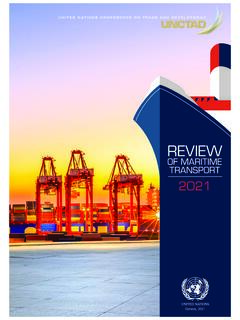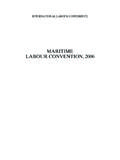Transcription of Globalisation, Transport and the Environment
1 1 Globalisation, Transport and the Environment OECD has recently analysed the impacts of globalisation on Transport levels, the consequences for the Environment , and the policy instruments that can be used to limit any negative impacts for the Environment . The key findings from this analysis are presented in this brief. How globalisation affects the Environment Overall impacts Before assessing how globalisation impacts on the Environment via changes taking place in the Transport sectors, it is important to remember that these are not the full impacts of globalisation on the Environment . In general, increased economic openness (mainly trade and investment liberalisation) seems to have had, at worst, a benign effect on emissions of localised pollutants. It has, for example, been found that (for the statistically average country), a 10% increase in trade intensity leads to approximately a 4% to 9% reduction in sulphur dioxide (SO2) concentrations.
2 Other studies have found that openness appears to have a beneficial impact on SO2 and nitrous dioxide (NO2), but no statistically significant impact on particle matter (PM) emissions. Still another study found that trade intensity increases land releases of pollutants, but either reduces or has no statistically significant effect on air, water and underground releases. Figure 1: Vessel traffic densities for year 2000 The graph below shows a ship-type dependent geographical distribution of maritime traffic, based on data from the Automated Mutual-Assistance Vessel Rescue System. These data illustrate large variations in traffic patterns (and emissions) for different ship types. Upper left: All cargo and passenger ships in the AMVER merchant fleet. Upper right: Oil tankers. Lower left: Bulk carriers.
3 Lower right: Container vessels. (Source: Endresen, et al. (2004), Challenges in Global Ballast Water Management , Marine Pollution Bulletin, Vol. 48, Issues 7-8.) 2 It is not clear how the relative price changes that result from openness will affect the environmental composition of economic activity: some countries will produce more environmentally intensive goods, others will produce fewer. On the other hand, liberalisation will raise incomes, perhaps increasing the willingness to pay for environmental improvements: these potential income effects could outweigh the negative scale effects associated with increased economic activity. When combined with the positive effects associated with technology transfer, the net effect on local pollutants could be positive. However, the evidence concerning carbon dioxide (CO2) and other greenhouse gas emissions is less encouraging, with the net effect of trade liberalisation likely to be negative.
4 One study, using a cross-section of 63 countries (and correcting for trade intensity and income) concluded that a 1% increase in trade leads to a increase in CO2 emissions for the average country. Other studies also find openness raises CO2 emissions, but the detrimental impact disappears when corrections are made for income levels, etc. One of the explanations for the pessimistic assessments of trade s impact on greenhouse gas emissions is their global nature. Not only are the costs of CO2 emissions shared with citizens abroad, but many greenhouse emissions are associated with fossil fuel use, for which few economically viable substitutes have emerged. The income and other technique effects that are largely responsible for reductions in local air pollutants do not seem to have the same force when the pollutant in question burdens the global population rather than just citizens residing within any one government s jurisdiction.
5 For example, unlike emissions by nationally based emission sources, international Transport -related emissions often involve third parties, many goods are moved via vessels not bound by operational regulations in the importing or exporting country. Thus, even if voters in high-income countries want stringent environmental regulations attached to the Transport of traded goods they consume, shipping emissions may be outside their government s jurisdiction. Globalisation and international Transport activity The 21st century has seen the continued internationalisation of the world s economy. There is also evidence of greater globalisation of cultures and politics. Economically, globalisation helps to facilitate the greater division of labour, and to exploit its comparative advantage more completely.
6 In the longer term, globalisation also stimulates technology and labour transfers, and allows the dynamism that accompanies entrepreneurial activities to stimulate the development of new technologies and processes that lead to global welfare improvements. Shipping Increasing globalisation has led to a strong increase in international shipping activity. Trade and shipping are closely linked, although some disagreement remains about the degree to which energy use in shipping is coupled with the movement of waterborne commerce. The estimates depend on the number of at-sea or in-port days that are assumed in the analysis. The available evidence largely indicates that world marine fleet energy demand is the sum of international fuel sales, plus domestically assigned fuel sales.
7 Some debate continues about the best estimates of global fuel usage, but the major elements of activity-based inventories are widely accepted. Considering the range of current estimates using activity-based input parameters, ocean-going ships now consume about 2% to 3% and perhaps even as much as 4% of world fossil fuels. Aviation Air Transport has also played a key part in fostering globalisation. However, airlines (and to an even greater degree, air Transport infrastructure) have had to respond to changing demands for their services. These demands come from the requirements for high-quality, fast and reliable international Transport . Globalisation, almost by definition, means demands for greater mobility and access, but these demands are increasingly different for different types of passengers and cargoes, to different places, and over different distances, than was previously the norm.
8 Many structural changes have taken place in the aviation sector as a result of globalisation. Air markets have been liberalised, the networks that airline companies operate have changed (often to hub-and-spoke networks), many new (often low-cost) companies have entered the market, and many (low-cost and other) airline companies have gone out of business or merged (most of the remaining airlines have already united into three major alliances). 3 International air Transport is now a major contributor to globalisation and is continually reshaping to meet the demands of the economic and social integration that globalisation engenders. Some 40% of world trade (by value) now moves by air. To allow the flows of ideas, goods and persons that facilitate efficiency on a global scale, air Transport has played a key role in the past, and is poised to continue this role in the future.
9 Yet, as the strong growth in air Transport activity is straining air-related infrastructure (such as airports), future economic growth in the sector could well be constrained by capacity limits. Road and rail With new developments to remove bottlenecks, combined with operational improvements, there is scope for considerable improvement in the efficiency of international road and rail freight in many regions. Of course, it is not simply a question of transit time and reliability, it is also a question of cost. In a comparison of total door-to-door Transport costs and transit times for a range of Transport solutions carrying cargo from Asia to Europe, air Transport had the highest cost, but very short transit times. Sea Transport provided the lowest cost, but had long transit times. Road freight fell between air and sea, both in terms of cost and transit time.
10 Rail Transport exhibited a very wide range of costs and transit times, and showed major differences between the officially scheduled transit times and the actual transit times achieved. Within the next 15 years, there seem to be limited opportunities to dramatically increase the speed of either ships or aircraft. Indeed, concern about CO2 emissions could lead to changes in the role of air freight within the supply chain. There have even been calls for sea freight Transport to operate at slower speeds, in order to save fuel. Given these uncertainties, it is interesting to note the particular potential for rail movement to offer opportunities for shorter transit times, and possibly, reduced costs. Road freight times may not have the scope to be reduced to the same extent. For both road and rail freight Transport , border crossings represent an important barrier to trade.
















